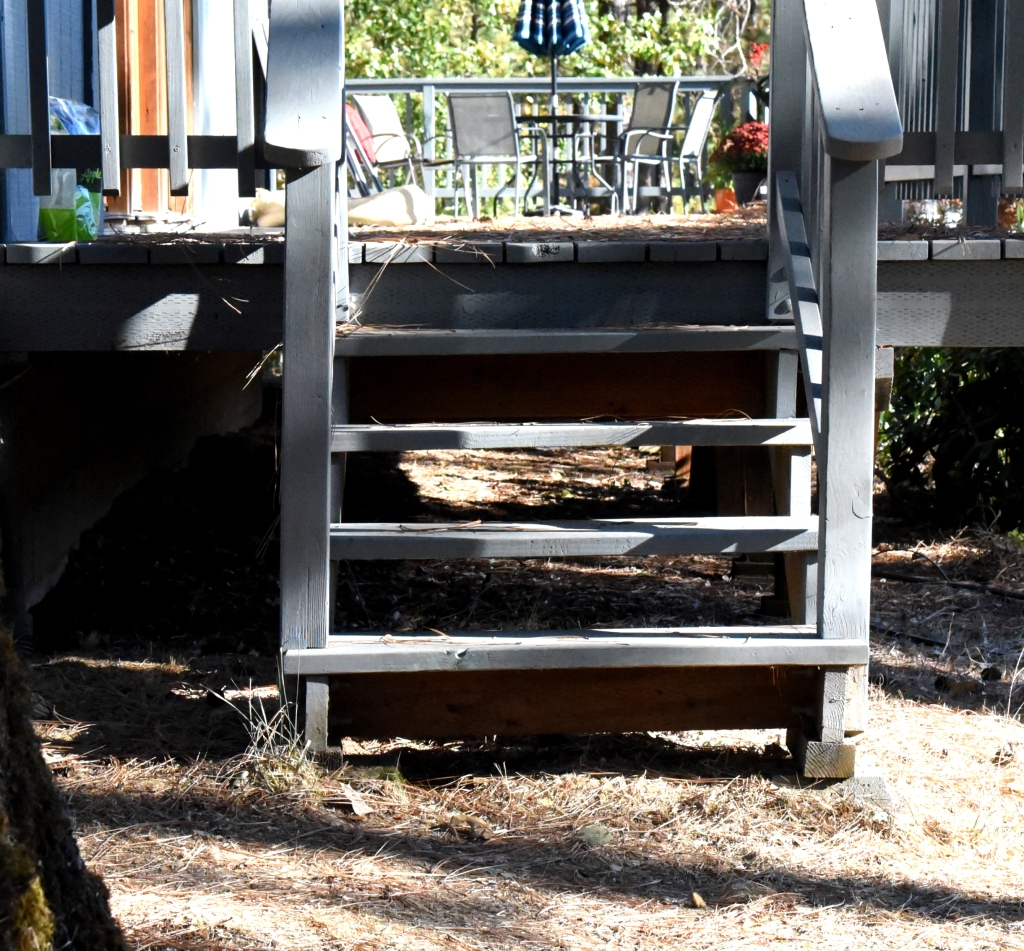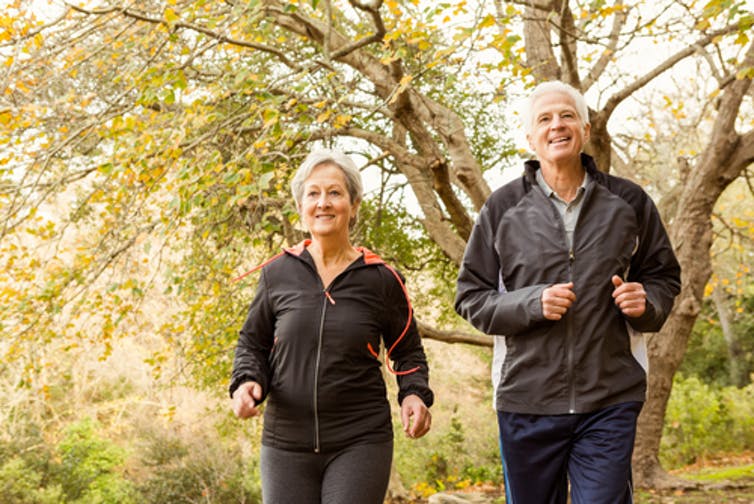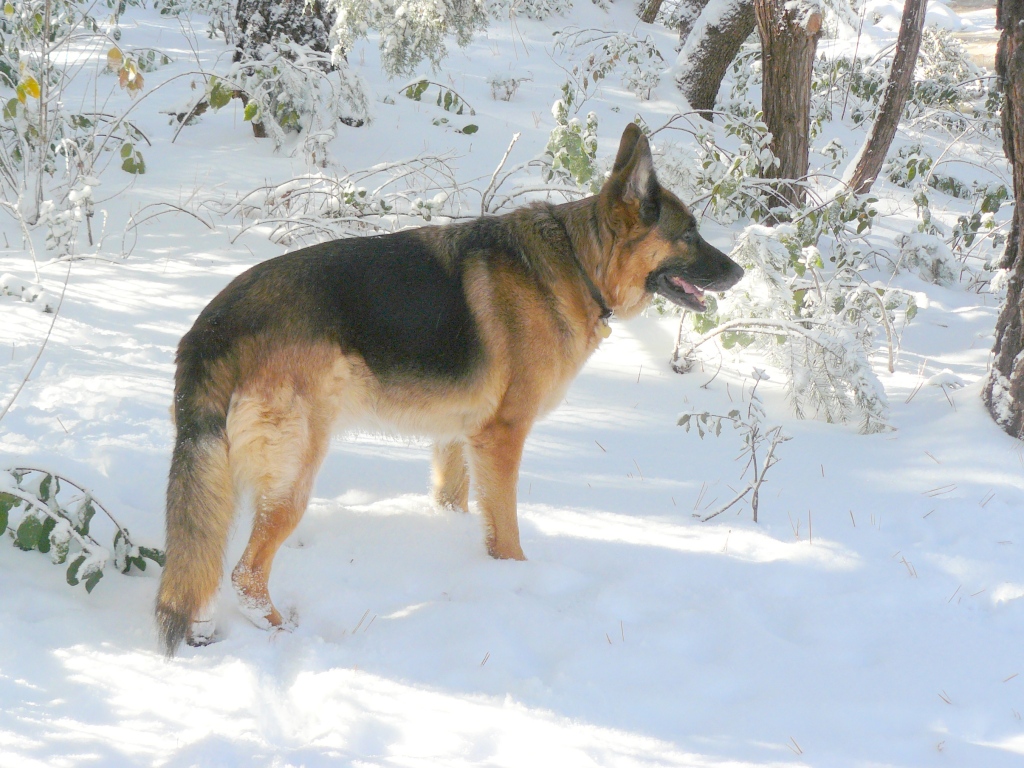And I am not speaking of the Autumn!
To be honest, dear friends, I really agonised over whether or not to republish an item that I saw on The Conversation blogsite last Friday. For it has nothing to do with dogs, nothing to do with learning from dogs, and everything to do with being the ‘wrong’ side of 65 years old.
But then one day last week I was out watching some tree cutting being undertaken by Jimmy Gonzales and his crew and heard the phoning ringing in the house.
I ran for the steps leading up to the deck and missed the bottom step.

I fell but luckily managed to grab the handrails seconds before I could have smacked my head into the steps. However, it did scare me especially when I reflected that it wasn’t even 9 months since my medical emergency following my fall from my bicycle.
It confirmed the sense in republishing the item. Republished within the terms of The Conversation site.
ooOOoo
Before the fall: How oldsters can avoid one of old age’s most dangerous events
September 21, 2018
By four authors:
![]() Co-Director of Texas A&M Center for Population Health and Aging, Texas A&M University
Co-Director of Texas A&M Center for Population Health and Aging, Texas A&M University
![]() Research Scientist, University of North Carolina at Chapel Hill
Research Scientist, University of North Carolina at Chapel Hill
![]() Regents and Distinguished Professor, Associate Vice President for Strategic Partnerships and Initiatives, Texas A&M University
Regents and Distinguished Professor, Associate Vice President for Strategic Partnerships and Initiatives, Texas A&M University
![]() Adjunct Assistant Professor, Public Health, University of North Carolina at Chapel Hill
Adjunct Assistant Professor, Public Health, University of North Carolina at Chapel Hill
Baby boomers, who once viewed themselves as the coolest generation in history, are now turning their thoughts away from such things as partying and touring alongside rock bands to how to they can stay healthy as they age. And, one of the most important parts of healthy aging is avoiding a fall, the number one cause of accidental death among people 65 and older.
The issue is growing more pressing each day. More adults than ever – 46 million – are 65 and older, and their numbers are increasing rapidly.
The Centers for Disease Control and Prevention estimates that one in four older adults will fall each year. Falls are the leading cause of injury and injury deaths among older adults. And, they are costly. Falls are responsible for an estimated US$31 billion in annual Medicare costs. This estimate does not account for non-direct medical or societal costs.
People who fall can lose their physical mobility for life, go into a hospital never to be discharged, require skilled nursing or other caregiver support, or become so fearful about falling again that they dramatically limit their daily activities.
The good news is that most falls are preventable, research has identified many modifiable risk factors for falls, and older adults can empower themselves to reduce their falls risks. This means there are opportunities to intervene in clinical and community settings to promote protective behaviors and improve safety.
A life-changing event
Falls can cause fractures, traumatic brain injuries and other conditions that require an emergency room visit or hospitalization. An older adult dies from a fall every 19 minutes, and every 11 seconds an older adult is treated in an emergency room for a fall-related injury. About one in four falls results in needed medical attention, and falls are responsible for about 95 percent of all hip fractures. In addition to the physical and mental trauma associated with the fall itself, falls often result in fear of falling, reduced quality of life, loss of independence and social isolation.

There is no single cause for falling. Falls can result from issues related to biological aging, such as balance problems, loss of muscle strength, changes in vision, arthritis or diabetes. Taking a combination of several prescription drugs can also contribute to falls. Lifestyle behaviors such as physical inactivity, poor nutrition and poor sleep quality can also increase the risk for falling. Environmental hazards inside the home, such as poor lighting and throw rugs, and outside, such as bad weather, standing water and uneven sidewalks, can create situations where falls are more likely to occur.
It takes a careful village
Because falls can be caused by many things, the solutions must also include a diverse set of systems, organizations and professionals. Toward that end, 42 active or developing state fall prevention coalitions, which coordinate initiatives and serve as advocates for policy development and community action, are in place. Their activities foster collaboration across the aging services network, public health and health care system. They do such things as host health fairs and fall risk screening events, fall prevention programs, and awareness-raising events to inform decision-makers and legislators about ways to make communities safer for older adults.
Here are some of the key objectives that the coalitions are working on to reduce hazards from falling:
- Enhance clinical-community collaboration for programming.
There are many fall prevention programs offered in communities to promote healthful behaviors and to reinforce positive mental perspectives about falls being preventable.
People concerned about falling should contact their local Area Agency on Aging to find out where these programs are offered and which can be most beneficial. Also, seniors should ask their doctors about fall-related risk factors and what they can do to reduce risk. Communicate your concerns about falls with your health care team and social network, tell them about what you learn during your fall prevention programs, and report back about how they are making a difference in your life.
- Manage chronic conditions.
About 70 percent of older adults have one or more chronic conditions, many of which can increase the risk for falling. For example, people with diabetes may have vision problems and problems with sensation in their feet. Also, the medications used to treat these conditions can increase fall risk. And, taking five or more medications has been identified with increased frailty and higher risk for falling.

While health care access and utilization are important for chronic disease diagnosis and management, 90 percent of health care happens outside the health care setting. Therefore, older adults need to manage their diseases better. To do this, however, they often need help. For starters, they should discuss the side effects of all medications with their doctors and also how best to adhere to prescribed treatment regimens, such as when to take medications, whether to take with food and whether there are possible interactions of one medication with another. Seniors also can consider enrolling in evidence-based disease self-management programs to improve their knowledge and confidence to manage their conditions as well as enhance lasting skills for goal setting and action planning, such as being physically active for 30 minutes a day for five days a week.
- Alter the physical environment.
About 44 percent of falls occur inside the home. In-home risk factors for falls can include dim lighting, clutter on floors, throw rugs and ottomans, missing railings, uncovered wires and extension cords, children and pets underfoot and unsafe bathrooms. A unsafe bathroom is one with an inappropriate toilet height, high shower or bathtub walls and no grab rails.
To identify possible risks in the home, the CDC created a user-friendly safety checklist that can safeguard older adults by eliminating environmental hazards.
- Maintain healthful behaviors.
Daily lifestyle behaviors such as physical activity, nutrition and sleep quality can influence fall risk, and these are never too late to change. Interventions can be successful for people of all ages. Among the most important is physical activity, namely safely performing lower-body exercises to increase strength, balance and flexibility. Additionally, seniors should work with their health care team to have medications reviewed and eyes checked regularly. Also, they should ask about their vitamin D levels and possible nutritional supplementation.
ooOOoo
Yes, when it comes to being more careful on our feet once again our dear dogs offer us a much better way: Have four of them!!

Just look at the ease of our dear Brandy scampering through the woods yesterday morning!

Our dear, sorely-missed Pharaoh demonstrating the advantages of four feet!
So my good people – you be careful out there!
My Grandmother starting declining rapidly after breaking her hip which caused her to fall. I am 52 years old. I take vitamins, I do physical activity at least 5 days a week & do yoga. I can’t stop time but I can prohibit certain things.
LikeLike
Well Susan, from where I observe the world you are just a youngster! 😅 However your Grandmother offers a very personal lesson for you. I do sense, reading between the lines, that you fully embrace, mentally and emotionally, the fact that at all ages we are in charge of our health but especially so as enter the Autumn of our life.
LikeLike
Thanks for this great article Paul. I am nearly 65. I notice that I have grown very cautious about stairs and uneven surfaces in the last year, which I put down to declining physical fitness and osteoarthritis in both knees. I will only wear lace up shoes or sand shoes and am surprised when I see older people who wear slip on shoes with no ankle support whatever. I will read the links you’ve provided carefully – prevention is better than cure.
I just love the photos of Pharoah and Brandy. The latter certainly “fell on his feet” 🙂 when you adopted him.
LikeLike
Well done, Margaret! I’m nearly 74 and notice many, too many, declines in body and mind. Loss of peripheral vision, forgetfulness, deteriorating balance, et al! But I can’t recommend too strongly the importance of diet and exercise. Thanks to Jeannie I am vegan, along with her, of course, and am compulsive about staying fit.
But, better written as BUT, ignoring the natural consequences of being old, pretending I am still a fit and able middle-aged man, is my blind spot. I must learn the balance between not taking stupid risks and not giving up.
That is not easy for me!
LikeLike
Wonderful article and so very true. 2 years your senior and proud owner of prosthetic elbow joint in my left arm due to a fall of only 3″. It doesn’t take much – its the landing that hurts. LOL
LikeLike
Oh, thank you Anita. Your reply reminds of that silly joke about the guy that fell off the roof of a block of high rise flats. As he passed an open window on the third floor, the owner of that particular flat called out: “How’s it going?” The faller replied: “So far, so good!”
(Sorry! I haven’t taken my pills yet!) 😉
LikeLike
Staying active makes getting old only slightly palatable. Sorry you missed that last step but glad to hear no serious damage was done. As I walk two standard poodles every day, I cannot tell you how many times I’ve ripped over an uneven sidewalk. A couple of times I have hurt myself, mostly though I just ear up favorite pants. I did have to chuckle at the author’s note: (the good news is that most falls are preventable) as I’m sure he’s never walked a couple of 60 lbs. dogs when they’ve spotted a nearby squirrel. No amount of prevention changes the fact that I’ll be turned into a human kite for a few seconds. I can only hope for a soft landing. 😉
LikeLike
Drat…make that tripped, not ripped and tear, not ear. Sorry. Too tiny a screen for these old eyes.
LikeLike
Better if I WRITE LIKE THIS? 😍 Or I could always open a window and shout! 🐶
LikeLiked by 1 person
No need to scream, I hear mostly well just can’t see the tiny print on a phone 🤣
LikeLike
I’m not far behind you!
LikeLiked by 1 person
Getting old ain’t for sissies!
LikeLike
Something I hear myself saying too often these days! Thank goodness when we are younger we don’t have a clue about this stage!
LikeLiked by 1 person
Yes this is a great reminder for us to all watch our steps.. I know I have fallen while out several times since I entered my sixth decade.. Hurting myself badly one time as I whacked my jaw on the pavement.. ,, My husband is more ( shusssh ) dare I say it.. Accident prone, and is often missing his steps.. or banging his head.. The thing I thing Our heads tell us we are still 21.. but our bodies are not keeping up… SO our feet lag behind..
So pleased you didn’t hurt yourself.. Our elderly neighbour a couple of months ago slipped and broke her hip , she broke her other one two years ago.. Just tripping in the home.. So its so easily done.
Take care..
LikeLiked by 1 person
That’s lovely of you to write that reply, Sue. Thank you! No question that we work so hard to hide the truth of how old we are from ourselves!
LikeLiked by 1 person
Keeping fit by walking and exercising as we age is a must.. As our balance so easily comes unstuck when we rush about as our minds never age but still think we can achieve things we used to.. Its not until the next day our muscles tell us differently 🙂
LikeLike
Oh, that is so true. Part of me doesn’t want to be more ‘gentile’ but another part of me keeps reminding me, most often the following morning, that I am not as young as I still kid myself to be!
LikeLiked by 1 person
You know, Paul, yoga certainly is not for everybody. But it can be a very grounding practice. I don’t go to classes, but both Chris and I stretch and ‘meditate ourselves into our bodies’ on a daily basis. Mindfulness might be a Buddhist practice, but then again, one only has to remain with life, in the body, moment by moment. I find if I am not mindful, I break things and stumble around like a drunkard 😉 So it gives me little choice but to return, again and again, to the breath, to the body, to This Moment. Aloha ❤
LikeLiked by 1 person
Bela, I do sense that I am getting closer and closer to the point of taking up some form of mindfulness. You offer a most convincing argument. As the old sages used to say that if one doesn’t try a new approach then one will never know if it will work! Thank you, Bela!
LikeLiked by 1 person
That much is true, Paul. I’ve resisted so much, but this aging thing is a whole new ballgame. And I – as you – want to stay healthy as long as possible. Aloha
LikeLike
Isn’t that the truth! Thank goodness that when we are younger we don’t have a clue about this ageing lark! I’m going for a massage next Monday at the same club where Jean goes for her RockSteady class. I am most definitely going to ask about meditation classes. Big hugs, Bela, and thank you!
LikeLiked by 1 person
Ohhh, good for you, Paul. We both (Chris is 20 years my junior but truly is the ‘old soul’ between us) have had biweekly massage for many years now. I don’t know how we would work as hard as we do without it. Good for you, so fabulous to give yourself this gift! And hang in there hon, because it’s a process of stripping off many layers of ‘stuff’ we’ve gathered over a lifetime. And yes, meditation classes sound wonderful as well! Wow, you are embarking on such a wondrous healing journey! Totally with you in spirit, and sending you my very best wishes! ❤
LikeLike
Thank you! 😍
LikeLiked by 1 person
Well, I am far behind you in age Paul, but can confirm that the springiness of age 30 has long gone. As my year ticks over into 61, I have noticed big changes this year. And I am clumsier than I used to be, so this is all good advice.
May I also suggest that you and Jean get plenty of B12. You likely have to supplement so that your nerve impulses and peripheral proprioception keeps working properly. Likewise, people tend to cut back on sodium to keep heart health, but salt in low amounts is absolutely necessary for synapses and response of the nervous system to produce muscle action.
Listen to ‘Sodium – in their Element’ on BBC World Service
https://www.bbc.co.uk/programmes/p002w557/episodes/player
LikeLike
Very sound advice. Both Jean’s PD doctor and a local doctor here in Grants Pass have advised us on what supplements to take when one is on a solely plant-based diet. It includes B12 and quite a few other supplements.
Keep taking the pills, as they say Colette! 😊
LikeLike